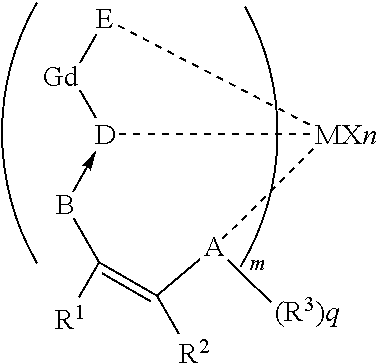Supported nonmetallocene olefin polymerization catalyst, preparation method and use thereof
a nonmetallocene olefin, polymerization technology, applied in the direction of catalyst activation/preparation, physical/chemical process catalysts, chemical/physical processes, etc., can solve the problems of increasing the production cost of polyolefins, affecting the properties of products, and affecting the continuous production in the industry. , to achieve the effect of low reactivity, high ring stress and high reactivity
- Summary
- Abstract
- Description
- Claims
- Application Information
AI Technical Summary
Benefits of technology
Problems solved by technology
Method used
Image
Examples
example i-1
[0241]In the following examples, the method for supporting a nonmetallocene catalyst on a composite carrier of high activity comprises mainly the following steps:
[0242]Preparation of a Supported Catalyst:
[0243]Heat-activation of the carrier: ES70 type silica (Ineos Corp.) was fluidized and overheat-activated at a constant temperature of 650° C. under a nitrogen gas atmosphere for 6 hrs.
[0244]Preparation of a modified carrier: 2 g of the overheat-activated ES70 silica was added with 40 ml toluene under stirring, then added further with 10 ml TiCl4(5 v / v % TiCl4 hexane solution) and reacted at 20° C. for 16 hrs, then was washed and filtered with 20 ml×3 toluene, finally vacuum dried to obtain a modified carrier.
[0245]Preparation of a composite carrier: 2 g anhydrous magnesium chloride was added with 40 ml THF, and added dropwise with 5 ml absolute ethanol, after fully dissolved at 50° C. under stirring for 2 hrs, added further with 2 g of the modified carrier and kept on stirring at 5...
reference example 2-1
[0403]Preparation of a supported catalyst: ES70 model silica (a product of Crosfield Corp) was fluidized and activated at a constant temperature of 650° C. under a nitrogen gas atmosphere for 6 hrs. An analytic pure magnesium chloride was calcined at 500° C. for 3 hrs to obtain an anhydrous magnesium chloride. 3 g anhydrous magnesium chloride was added with 60 ml of a refined tetrahydrofuran(THF) under a nitrogen gas atmosphere (the respective content of water and oxygen is less than 5 ppm), then added dropwise with 2.5 ml of a refined absolute ethyl alcohol, added further with 3 g of the heat-activated ES70 carrier, then reacted at 20° C. under stirring for 18 hrs, the mixture was washed with 30 ml×4 toluene, and filtered, finally vacuum dried to obtain a composite carrier, 5 g. The composite carrier was added with 50 ml toluene, then added dropwise with 5 ml methylaluminoxane (10 wt % MAO toluene solution) and 25 ml TiCl4(5 v / v % TiCl4 hexane solution), and then reacted at 20° C. ...
example 2-1
[0405]Preparation of a supported catalyst: 2 g of the heat-activated ES70 silica from Reference Example 2-1 was added with 40 ml toluene and stirred, then added further with 10 ml TiCl4 (5 v / v % TiCl4 hexane solution) and reacted at 20° C. for 16 hrs, then was washed with 20 ml×3 toluene, filtered, finally vacuum dried. 2 g anhydrous magnesium chloride was added with 40 ml THF, added dropwise with 5 ml absolute ethyl alcohol, and added with the aforementioned carrier and stirred at 50° C. for 4 hrs, then the mixture was washed with 20 ml×4 toluene, filtered and finally vacuum dried to obtain 2.9 g of a composite carrier. The composite carrier was added with 40 ml toluene, then added dropwise with 2.9 ml methylaluminoxane (15 wt % MAO toluene solution) and 15 ml TiCl4 (5 v / v % TiCl4 hexane solution) and then reacted at 20° C. under stirring for 2 hrs. The mixture was washed with 30 ml toluene, filtered, and vacuum dried, then added further with 0.256 g of the nonmetallocene catalyst / ...
PUM
| Property | Measurement | Unit |
|---|---|---|
| temperature | aaaaa | aaaaa |
| pressure | aaaaa | aaaaa |
| temperature | aaaaa | aaaaa |
Abstract
Description
Claims
Application Information
 Login to View More
Login to View More - R&D
- Intellectual Property
- Life Sciences
- Materials
- Tech Scout
- Unparalleled Data Quality
- Higher Quality Content
- 60% Fewer Hallucinations
Browse by: Latest US Patents, China's latest patents, Technical Efficacy Thesaurus, Application Domain, Technology Topic, Popular Technical Reports.
© 2025 PatSnap. All rights reserved.Legal|Privacy policy|Modern Slavery Act Transparency Statement|Sitemap|About US| Contact US: help@patsnap.com



